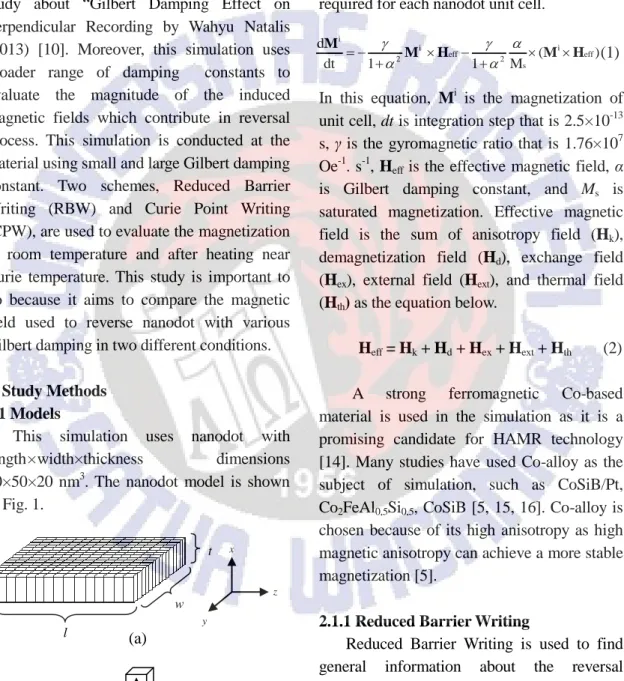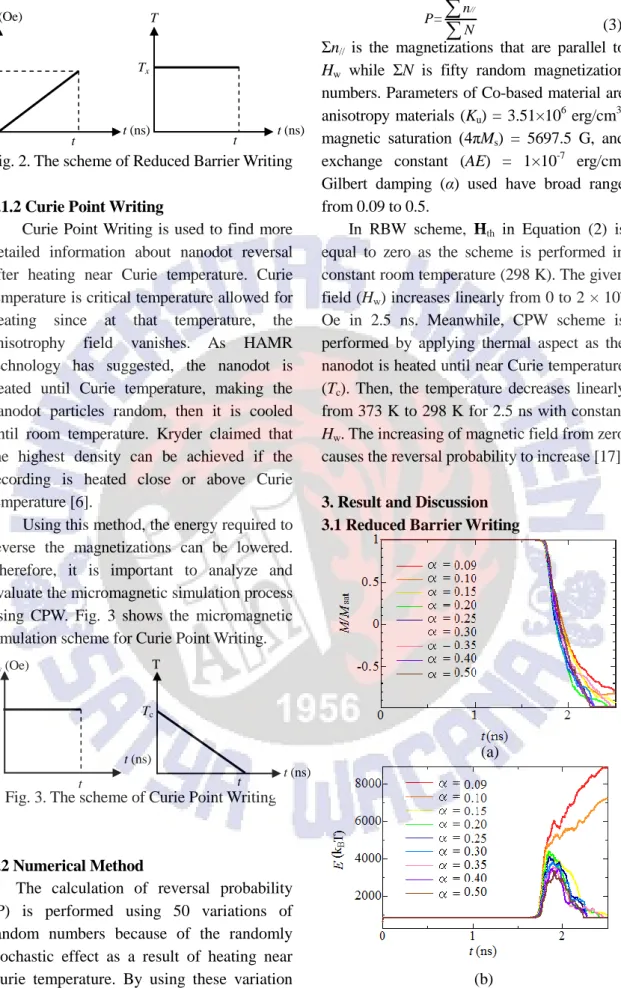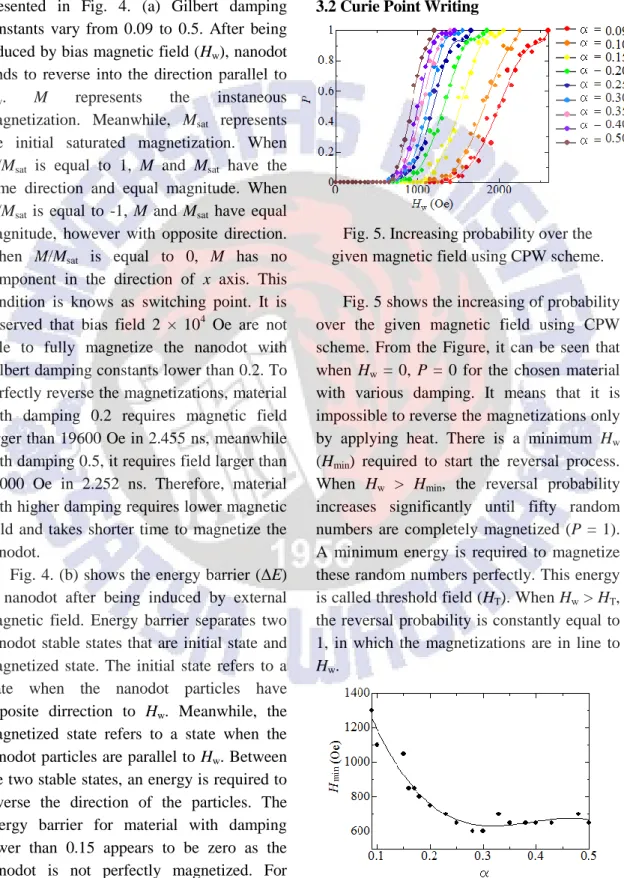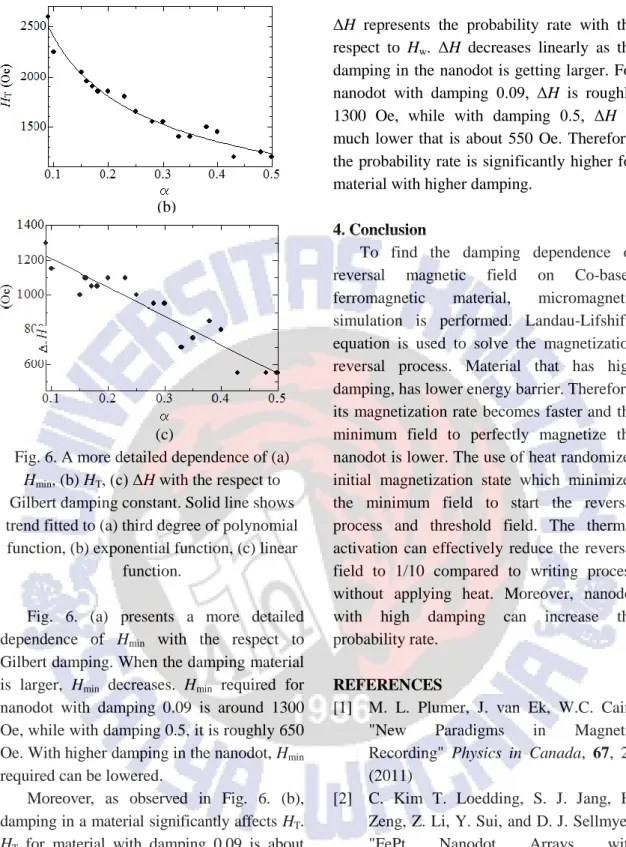DAMPING
DEPENDENCE OF
REYERSAL MAGNETIC FIELD
ON
CO=BASED
NANO=FERROMAGNETIC \ryITH
THERMAL
ACTIVATION
Oleh:
Nadia Ananda Herianto
NIM:
192010005TUGAS
AI(HIR
Diajukan kepada Program Studi: Pendidikan Fisikq Fakultas: Sains dan Matematika, guna
memenuhi sebagian dari persyaratan untuk mencapai gelar Sarjana Pendidikan
Disetujui oleh,
Pembimbing Utama, Pembimbing Pendamping,
Prof. Dr. Ferdy S Rondonuwu, S.Pd., M.Sc
Disahkan oleh,
Nur Aji Wibowo, S.Si., M.Si
Diketahui oleh,
Kaprogdi,
Dra. Manni Sudarmi, M.Si
FAKULTAS
SAINSDAN
MATEMATIKA
UNIVERSITAS KRISTEN SATYA
WACAIYASALAfIGA
ffi
PERNYATAAN
TIDAK
PLI\GIAT
Saya yang bertanda tangan di bawah ini:
Nama
NIM Fakultas
Judul tugas akhir
Pembimbing
2.
Prof. Dr. Ferdy S Rondonuwu, S.Pd., M.ScDengan ini menyatakan bahwa:
1. Hasil karya yang saya serahkan
ini
adalah asli dan belum pernah diajukan untuk mendapatkan gelar kesarjanaan baik di Universitas Kristen Satya Wacana maupun di institusi pendidikan lainnya.2.
Hasil karya sayaini
bukan saduran/terjemahan melainkan merupakan gagasan, rumusan, dan hasilpelaksanaan penelitian/implementasi saya sendiri, tanpa bantuan pihak lain, kecuali arahan pembimbing
akademik dan narasumber penelitian.
3.
Hasil karya saya ini merupakan hasil revisi terakhir setelah diujikan yang telah diketahui dan disetujui olehpembimbing.
4.
Dalam karya saya ini tidak terdapat karya atau pendapat yang telah ditulis atau dipublikasikan orang lain, kecuali yang digunakan sebagai acuan dalam naskah dengan menyebutkan nama pengarang dan dicantumkan dalam daftar pustaka.Pernyataan
ini
saya buat dengan sesungguhnya. Apabiladi
kemudian hari terbukti ada penyimpangan danketidakbenaran dalam pernyataan ini maka saya bersedia menerima sanksi akademik berupa pencabutan gelar
yang telah diperoleh karena karya saya
ini,
serta sanksi lain yang sesuai dengan ketentuan yang berlaku di Universitas Kristen Satya Wacana.PERPUSTAKAAN UNIvERSITAS
LIN MRSiT.{S KR{STE :\i SAT'Y.{ 1VACA}iA
Jl. 1)ig*egorc 51 6* Saialita 5i1f 1 !
Jarr* -Ie:rgal:, ir:dori<riia
-frip {}3!i{ }i
I I 12. l:*x. i}l9$ ll !4lJ
trn:aii ; iii:r.x'ic;,athu. uksw.edr : 1:tt3: l.i iil>r:n, uks:1 .r{h!
Nadia Ananda Herianto
19201 0005
Sains dan Matematika
DAMPING DEPENDENCE OF REVERSAL MAGNETIC FIELD ON CO-BASED
NANO-FERROMAGNETIC WITH THERMAL ACTTVATION
l. Nur Aji Wibowo, S.Si., M.Si
.Ianuari 2015
ffi
PERPUSTAKAAN UNTvERSITAStlN IYERSITAS Kt{iSTE:\ S,LTYA W ACANA
Ji, {}iy,urelorc i2 h{1 lalatiga !071 I
Jarta -l'eugafo , l*lsresia 'l-cip' {ilafr llilii' Far' {ilg$ lll'r}3
lraii : lihrani4+lrr: -uiirrr, *lu ; lrttp: -1 : lfiran . ulisrr. elu
Saya yang bertanda tangan di bawah ini:
PERNYATAAN
PERSETUJUAN AKSES
Nama Nitui
Fakultas
Judul tugas akhir
Nadia Ananda Herianto 1 9201 000s
Sains dan Matematika
:
I}AMPING DEPENDENCE OT REVERSAL MAGNETIC FIELD ON CO.BASEDNAI\O.FERROMAGII'ETIC WITH THERMAL ACTTVATION
Dengan ini saya menyerahkan hak non-eksHusif kepada Perpustakaan Universitas
-
Universitas Kristen Satya Wacana untuk menyimpan, mengatur akses serta melakukan pengelolaan terhadap karya sayaini
denganmengacu pada ketentuan akses tugas akhir elektronik sebagai berikut (beri tanda pada kotak yang sesuai):
fl
a.
Saya mengijinkan karya tersebut diunggahke
clalam aplikasi Repositori PerpustakaanUniversitas,danlatauportal GARUDA
E
b.
Saya tidak mengijinkan karya tersebut diunggah ke dalam aplikasi Repositori Perpustakaan Universitas, dan/atauportal GARUDA*'t(hcngo
ab strak sdia)*
Hak yang tidak terbatashanya bagi satu pihak saja. Pengajar, peneliti, dan mahasiswa yang menyerahlan hak non-ekslustf kepada i Repositari Perpuslakasn Ufiiversilqs saat tflevgutnp:ulkan hasil larya ntereka mas.ih, ntemiliki hak copyright atas karyatersebut.
i
**
Hanya akan menampillan halaman judul dan abstrak Pilihan ini harus dilampiri dengan penjelasan/ alasan tertulis dari pembimbing TAiDemikian pemyataan ini saya buat dengan sebenarnya.
Salatiga, 1E Janrrari 2015
Nadia Ananda Herianto
Prof. Dr. Ferdy S Rondonuwu, S.Pd., M.Sc
DAMPING DEPENDENCE OF REVERSAL MAGNETIC FIELD ON
CO-BASED NANO-FERROMAGNETIC WITH THERMAL
ACTIVATION
1)Nadia Ananda Herianto, 2) Ferdy Semuel Rondonuwu, 2)Nur Aji Wibowo
1)
Pendidikan Fisika, Fakultas Sains dan Matematika, Universitas Kristen Satya Wacana 2)
Fisika, Fakultas Sains dan Matematika, Universitas Kristen Satya Wacana Jl. Diponegoro No.52-60, Salatiga (50711)
ABSTRACT
Currently, hard disk development has used HAMR technology that applies heat to perpendicular media until near Curie temperature, then cools it down to room temperature. The use of HAMR technology is significantly influence by Gilbert damping constants. Damping affects the magnetization reversal and coercivity field. Simulation is used to evaluate magnetization reversal by completing Landau-Lifshitz-Gilbert explicit equation. A strong ferromagnetic cobalt based material with size 50×50×20 nm3 is used which parameters are anisotropy materials 3.51×106 erg/cm3, magnetic saturation 5697.5 G, exchange constant 1×10-7 erg/cm, and various Gilbert damping from 0.09 to 0.5. To observe the thermal effect, two schemes are used which are Reduced Barrier Writing and Curie Point Writing. As a result, materials with high damping is able to reverse the magnetizations faster and reduce the energy barrier. Moreover, it can lower the minimum field to start the magnetizations reversal, threshold field, and probability rate. The heating near Curie temperature has succeded in reducing the reversal field to 1/10 compared to writing process in absence of thermal field.
NOMENCLATURE Mi = magnetization of unit cell
dt = integration step γ = gyromagnetic ratio
Hw = given bias magnetic field
Heff = effective magnetic field
Hk = anisotropy field
Hd = demagnetization field
Hex = exchange field
Hext = external field
Hth = thermal field HT = threshold field
Hmin = minimum field to start the reversal process
Ms = saturation magnetization
α = Gilbert damping constant Tx = room temperature
Tc = Curie temperature
t = time
Σn// = magnetization parallel to Hw
ΣN = fifty random magnetization numbers
Ku = anisotropy material
AE = exchange constant
ΔE = energy barrier
P = reversal probability
ΔH = field gap
1. Introduction
For over 55 years, the densities of hard disk have increased to the level of Tbit/in2 [1]. Current technologies have been trying to achieve densities toward and beyond 1 Tbit/in2 [2]. Several technologies, such as Seagate hard disk, have used HAMR (Heat-Assisted Magnetic Recording) technology to increase hard disk capacity into 6 TB and 8 TB even 10 TB in the future [7]. Perpendicular magnetic recording has been widely used and developed to increase the storage capacity by reducing the size of the magnetic particles [3]. Perpendicular magnetic recording can achieve storage density three times better than the longitudinal magnetic recording [4]. Perpendicular magnetic recording can be achieved by aligning the poles of magnetic
elements perpendicularly rather than longitudinally. However, by reducing the size of the nanodot, the particles stability decreases [3]. This is known as superparamagnetic limit. Therefore, the use of high anisotropy materials is proposed to solve this problem. High anisotropy materials can be used to lower the switching current as well as increase the thermal stability of the particles [5]. Another problem rises from the use of high anisotropy. High anisotropy use makes energy barrier becomes greater; therefore nanodot takes longer time and is more difficult to magnetize [3]. HAMR is one of the solutions proposed to counter this problem. This technology uses laser to heat the particles until near Curie temperature, then rapidly cool them down until room temperature. The heat makes the particles go randomly; therefore, it is capable of lowering the energy required to reverse the nanodots [6].
Several studies have researched about the use of HAMR technology. Budi (2013) found that Gilbert damping affects coercivity field [8]. Coercivity field is the required field to reverse the magnetic moments [3]. In line with Budi, Schrefl et al (2001) posited that magnetization reversal depends highly on the given Gilbert damping constant [9]. Meanwhile, Nur Aji Wibowo (2014) found that magnetization reversal can be realized through an extremely fast heating, followed by rapid cooling [17].
One of the factors affecting the use of HAMR technology is Gilbert damping. Gilbert damping refers to the magnetic moment relaxation in a nanodot. The higher the Gilbert damping, the easier magnetic moments will reverse. Therefore, Gilbert damping affects the magnetization rate [8, 9]. Moreover, Gilbert damping also affects the energy barrier and the reversal field [10]. The decreasing of Gilbert damping causes coercivity field to increase [8]. Moreover, Gilbert damping effectiveness can be changed by modifying the material’s concentration, changing the film thickness,
and annealing [11, 12]. With the reduction of the nanodot size in magnetic technologies, it is extremely important to understand the nanodot magnetization below micron scales. Therefore, simulation is performed to find more information on detailed magnetization configurations as well as predict the nanodots capabilities [13].
This study is a continuation of previous study about “Gilbert Damping Effect on Perpendicular Recording by Wahyu Natalis (2013) [10]. Moreover, this simulation uses broader range of damping constants to evaluate the magnitude of the induced magnetic fields which contribute in reversal process. This simulation is conducted at the material using small and large Gilbert damping constant. Two schemes, Reduced Barrier Writing (RBW) and Curie Point Writing (CPW), are used to evaluate the magnetization in room temperature and after heating near Curie temperature. This study is important to do because it aims to compare the magnetic field used to reverse nanodot with various Gilbert damping in two different conditions.
2. Study Methods 2.1 Models
This simulation uses nanodot with length×width×thickness dimensions 50×50×20 nm3. The nanodot model is shown in Fig. 1.
(b)
Fig. 1. (a) Perpendicular magnetized nanodot model, which is divided into 15 × 15 unit
cells. (b) Each cell represents a single direction of magnetization.
Each cell represents a single direction of magnetization. A thickness of 20 nm is chosen in reference to many studies that have used this dimension to do micromagnetic simulation [8, 10, 14, 16]. The simulation is performed using modified micromagnetic simulator by applying thermal aspect. Landau-Lifshitz-Gilbert (LLG) explicit equation is used to solve the total magnetic moments (Mi) required for each nanodot unit cell.
(1)
In this equation, Mi is the magnetization of unit cell, dt is integration step that is 2.5×10-13 s, γ is the gyromagnetic ratio that is 1.76×107 Oe-1. s-1, Heff is the effective magnetic field, α
is Gilbert damping constant, and Ms is
saturated magnetization. Effective magnetic field is the sum of anisotropy field (Hk),
demagnetization field (Hd), exchange field
(Hex), external field (Hext), and thermal field
(Hth) as the equation below.
Heff = Hk + Hd + Hex + Hext + Hth (2)
A strong ferromagnetic Co-based material is used in the simulation as it is a promising candidate for HAMR technology [14]. Many studies have used Co-alloy as the subject of simulation, such as CoSiB/Pt, Co2FeAl0,5Si0,5, CoSiB [5, 15, 16]. Co-alloy is
chosen because of its high anisotropy as high magnetic anisotropy can achieve a more stable magnetization [5].
2.1.1 Reduced Barrier Writing
Reduced Barrier Writing is used to find general information about the reversal magnetic process, such as the minimum Gilbert damping constant and energy required to reverse the nanodot. Fig. 2 shows the micromagnetic simulation scheme for RBW.
y z x (a) i i i eff eff 2 2 s d ( ) dt 1 1 M M M H M H l w t
t (ns) Hw (Oe) Hw t T t (ns) t Tx
Fig. 2. The scheme of Reduced Barrier Writing
2.1.2 Curie Point Writing
Curie Point Writing is used to find more detailed information about nanodot reversal after heating near Curie temperature. Curie temperature is critical temperature allowed for heating since at that temperature, the anisotrophy field vanishes. As HAMR technology has suggested, the nanodot is heated until Curie temperature, making the nanodot particles random, then it is cooled until room temperature. Kryder claimed that the highest density can be achieved if the recording is heated close or above Curie temperature [6].
Using this method, the energy required to reverse the magnetizations can be lowered. Therefore, it is important to analyze and evaluate the micromagnetic simulation process using CPW. Fig. 3 shows the micromagnetic simulation scheme for Curie Point Writing.
Fig. 3. The scheme of Curie Point Writing
2.2 Numerical Method
The calculation of reversal probability (P) is performed using 50 variations of random numbers because of the randomly stochastic effect as a result of heating near Curie temperature. By using these variation of random orientations, the reversal probability can be formulated using the following equation.
(3) Σn// is the magnetizations that are parallel to Hw while ΣN is fifty random magnetization numbers. Parameters of Co-based material are anisotropy materials (Ku) = 3.51×10
6
erg/cm3, magnetic saturation (4πMs) = 5697.5 G, and
exchange constant (AE) = 1×10-7 erg/cm. Gilbert damping (α) used have broad range from 0.09 to 0.5.
In RBW scheme, Hth in Equation (2) is
equal to zero as the scheme is performed in constant room temperature (298 K). The given field (Hw) increases linearly from 0 to 2 × 10
4
Oe in 2.5 ns. Meanwhile, CPW scheme is performed by applying thermal aspect as the nanodot is heated until near Curie temperature (Tc). Then, the temperature decreases linearly
from 373 K to 298 K for 2.5 ns with constant
Hw. The increasing of magnetic field from zero causes the reversal probability to increase [17].
3. Result and Discussion 3.1 Reduced Barrier Writing
(a)
(b)
Fig. 4. (a) Magnetization of material based on Co-alloy with dimension 50×50×20 nm3
under bias magnetic field at room Tc t (ns) t T Hw (Oe) Hw t (ns) t // n P= N
temperature. (b) Energy barrier of nanodot with dimension 50×50×20 nm3 at room
temperature.
The magnetization reversal process under bias magnetic field at room temperature is presented in Fig. 4. (a) Gilbert damping constants vary from 0.09 to 0.5. After being induced by bias magnetic field (Hw), nanodot
tends to reverse into the direction parallel to
Hw. M represents the instaneous magnetization. Meanwhile, Msat represents
the initial saturated magnetization. When
M/Msat is equal to 1, M and Msat have the
same direction and equal magnitude. When
M/Msat is equal to -1, M and Msat have equal
magnitude, however with opposite direction. When M/Msat is equal to 0, M has no
component in the direction of x axis. This condition is knows as switching point. It is observed that bias field 2 × 104 Oe are not able to fully magnetize the nanodot with Gilbert damping constants lower than 0.2. To perfectly reverse the magnetizations, material with damping 0.2 requires magnetic field larger than 19600 Oe in 2.455 ns, meanwhile with damping 0.5, it requires field larger than 18000 Oe in 2.252 ns. Therefore, material with higher damping requires lower magnetic field and takes shorter time to magnetize the nanodot.
Fig. 4. (b) shows the energy barrier (ΔE) in nanodot after being induced by external magnetic field. Energy barrier separates two nanodot stable states that are initial state and magnetized state. The initial state refers to a state when the nanodot particles have opposite dirrection to Hw. Meanwhile, the
magnetized state refers to a state when the nanodot particles are parallel to Hw. Between
the two stable states, an energy is required to reverse the direction of the particles. The energy barrier for material with damping lower than 0.15 appears to be zero as the nanodot is not perfectly magnetized. For nanodot with damping 0.15, ΔE is roughly
4370 103 kBT, meanwhile with damping 0.5,
the ΔE is around 3340 kBT. ΔE to reverse
magnetizations with higher damping, is lower. This low energy barrier causes the Hw
to decrease.
3.2 Curie Point Writing
Fig. 5. Increasing probability over the given magnetic field using CPW scheme.
Fig. 5 shows the increasing of probability over the given magnetic field using CPW scheme. From the Figure, it can be seen that when Hw = 0, P = 0 for the chosen material
with various damping. It means that it is impossible to reverse the magnetizations only by applying heat. There is a minimum Hw
(Hmin) required to start the reversal process.
When Hw > Hmin, the reversal probability
increases significantly until fifty random numbers are completely magnetized (P = 1). A minimum energy is required to magnetize these random numbers perfectly. This energy is called threshold field (HT). When Hw > HT,
the reversal probability is constantly equal to 1, in which the magnetizations are in line to
Hw.
(b)
(c)
Fig. 6. A more detailed dependence of (a)
Hmin, (b) HT, (c) ΔH with the respect to
Gilbert damping constant. Solid line shows trend fitted to (a) third degree of polynomial function, (b) exponential function, (c) linear
function.
Fig. 6. (a) presents a more detailed dependence of Hmin with the respect to
Gilbert damping. When the damping material is larger, Hmin decreases. Hmin required for
nanodot with damping 0.09 is around 1300 Oe, while with damping 0.5, it is roughly 650 Oe. With higher damping in the nanodot, Hmin
required can be lowered.
Moreover, as observed in Fig. 6. (b), damping in a material significantly affects HT. HT for material with damping 0.09 is about 2600 Oe. For nanodot with damping 0.5, the
HT is approximately 1200 Oe. Therefore, higher Gilbert damping is required to reach lower HT. By applying heat, initial magnetizations become random which reduce the HT around 16800 Oe for damping 0.5
compared to RBW scheme.
Fig. 6(c) shows the dependence of ΔH with the respect to Gilbert damping constants.
ΔH represents the probability rate with the respect to Hw. ΔH decreases linearly as the
damping in the nanodot is getting larger. For nanodot with damping 0.09, ΔH is roughly 1300 Oe, while with damping 0.5, ΔH is much lower that is about 550 Oe. Therefore, the probability rate is significantly higher for material with higher damping.
4. Conclusion
To find the damping dependence of reversal magnetic field on Co-based ferromagnetic material, micromagnetic simulation is performed. Landau-Lifshiftz equation is used to solve the magnetization reversal process. Material that has high damping, has lower energy barrier. Therefore, its magnetization rate becomes faster and the minimum field to perfectly magnetize the nanodot is lower. The use of heat randomizes initial magnetization state which minimizes the minimum field to start the reversal process and threshold field. The thermal activation can effectively reduce the reversal field to 1/10 compared to writing process without applying heat. Moreover, nanodot with high damping can increase the probability rate.
REFERENCES
[1] M. L. Plumer, J. van Ek, W.C. Cain, "New Paradigms in Magnetic Recording" Physics in Canada, 67, 25 (2011)
[2] C. Kim T. Loedding, S. J. Jang, H. Zeng, Z. Li, Y. Sui, and D. J. Sellmyer, "FePt Nanodot Arrays with Perpendicular Easy Axis, Large Coercivity, and Extremely High Density" Applied Physics Letters, 91, 172508 (2007) DOI: 10.1063/1.2802038 [3] R. Radhakrishnan, B. Vasi, F. Erden, and C. He, "Characterization of Heat-Assisted Magnetic Recording Channels"
DIMACS Series in Discrete Mathematics and Theoretical Computer
Science, 73, 25-41 (2007)
[4] M. Rick, "Hard Drives Go Perpendicular"
http://www.eetimes.com/document.asp? doc_id=1156534, September 26 (2005) [5] H. I. Yim, J. S. Park, J. Y. Hwang, S. B.
Lee, and T. W. Kim, "Perpendicular Magnetic Anisotropy of CoSiB/Pt Multi Layers" Journal of the Korean Physical
Society, 57, 1672-1674 (2010) DOI:
10.3938/jkps.57.1672
[6] M. H. Kryder, E. C. Gage, T. W. McDaniel, W. A. Challener,
R. E. Rottmayer, R.E. G. Ju, R.E. Y.T. Hsia, and M. F. Erden, "Heat Assisted Magnetic Recording" Proceedings of
the IEEE, 96, 1810-1835 (2008) DOI:
10.1109/JPROC.2008.2004315
[7] S. Anthony, “Seagate Starts Shipping 8 TB Hard Drives with 10 TB and HAMR on the Horizon” http://www. extremetech.com/computing/186624- seagate-starts-shipping-8tb-hard-drives-with-10tb-and-hamr-on-the-horizon, July 21 (2014)
[8] Budi Purnama, Ismail, and Suharyana, "Kajian Simulasi Mikromagnetik Ketergantungan medan koersif dengan besaran intrinsik nanodot magnetik dengan Anisotropi tegak lurus" Jurnal
Fisika dan Aplikasinya, 9, 30-33 (2013)
[9] T. Schrefl, H. Forster, D. Suess, W. Scholz, V. Tsiantos, and J. Fidler, "Micromagnetic Simulation of Switching Events" Advances in Solid
State Physics, 41, 623-635 (2001) DOI:
10.1007/3-540-44946-9_50
[10] W. N. Handayani, A. Setiawan, and N. A. Wibowo, "Gilbert Damping Effect on Thermally Assisted Magnetization Reversal of Perpendicular Magnetized Nano-Dot" International Journal of
Science and Engineering Investigations,
2, 26-31 (2013)
[11] Kh. Zakeri, J. Lindner, I. Barsukov, R. Meckenstock, M. Farle, U. von Hörsten,
H. Wende, W. Keune, J. Rocker, S. Kalarickal, K. Lenz, W. Kuch, K. Baberschke, and Z. Frait, "Spin Dynamics in Ferro-magnetics: Gilbert Damping and Two-Magnon Scatering"
Physical Review, 76, 104416 (2007)
DOI:10.1103/PhysRevB.76.104416 [12] S. Serrano-Guisan, Han-Chun Wu, C
Boothman, M. Abid, B. S. Chun, I. V. Shvets, and H. W. Schumacher,"Thickness Dependence of The Effective Damping in Epitaxial Fe3O4/ MgO Thin Films" Journal of Applied Physics, 109, 013907 (2011)
DOI: 10.1063/1.3531989
[13] E. D. Dahlberg and J. G. Zhu, "Micromagnetic Microscopy and Modelling" Physics Today, 48, 34-40 (1995) DOI: 10.1063/1.881447 (1995) [14] N. A. Wibowo, Cari, and B. Purnama,
"Heat Assisted Magnetization Reversal on Perpendicular Magnetized Nano-Dot" IPTEK, The Journal for
Technology and Science, 22, 57-64
(2011)
DOI: 10.12962/j20882033.v22i2.64 [15] S. Wang, X. Q. Li, L. J. Bai, X. G. Xu,
J. Miao, and Y. Jiang, "Strong Perpendicular Magnetic Anisotropy in Co2FeAl0,5Si0,5 Film Sandwiched By
MgO Layers" Chinese Physical Society,
22, 057305 (2013) DOI:
10.1088/1674-1056/22/5/057305
[16] A. Candra D.P, S. Trihandaru, and N. A. Wibowo, "Micro Magnetic Study of Thermally Assisted Magnetization Reversal mechanism on Perpendicularly Magnetic Anisotropy CoxSIyBz"
International Journal of Science and Research (IJSR), 2, 48-52 (2013)
[17] N. A. Wibowo, F. S. Rondonuwu, and B. Purnama, "Low Writing Field on Perpendicular Nano-ferromagnetic"
Journal of Magnetics, 19, 273-240
(2014)



